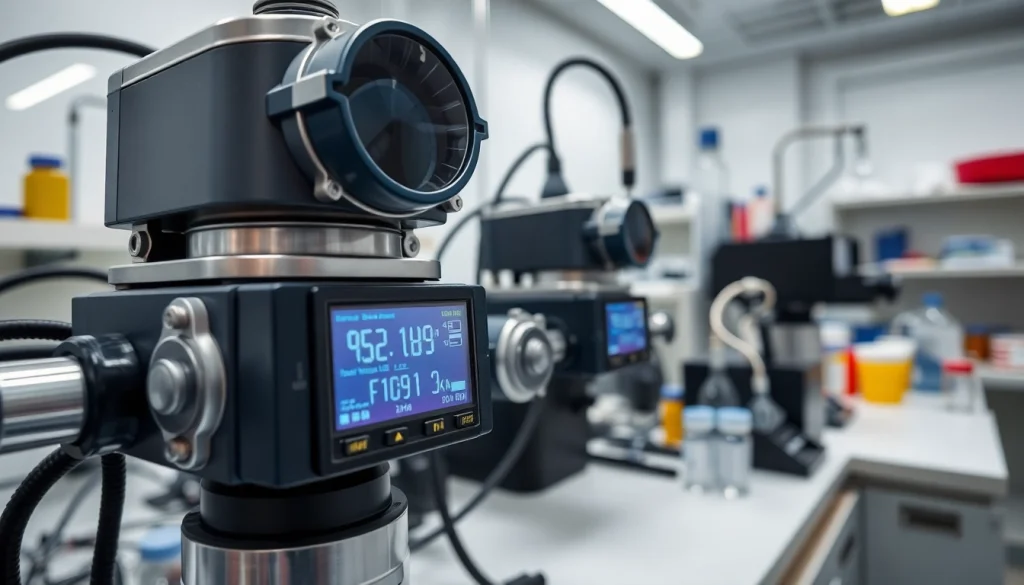Ensuring Safety: Comprehensive Guide to Hydrogen Cyanide Detection Methods

Understanding Hydrogen Cyanide: Properties and Risks
Hydrogen cyanide (HCN) is a highly toxic compound that poses significant health and safety risks in various industrial settings. Understanding its properties and the associated risks is crucial for effective detection and prevention measures. This article explores the chemical composition of hydrogen cyanide, its health impacts, common sources, and the technologies and best practices for detection.
Chemical Composition and Behavior
Hydrogen cyanide is a volatile liquid at room temperature, with a boiling point of 25.7 °C (78.3 °F). Its chemical structure comprises a carbon atom triple-bonded to a nitrogen atom and attached to a hydrogen atom (HC≡N), making it a simple yet potent compound. This unique configuration contributes to its properties, such as its low molecular weight, and the ability to exist in gaseous form at room temperature, which enhances its mobility and potential for exposure.
Health Impacts of Hydrogen Cyanide Exposure
Exposure to hydrogen cyanide can lead to severe health implications, including headache, dizziness, confusion, respiratory distress, and in extreme cases, death. HCN interferes with the body’s ability to use oxygen, leading to cellular asphyxiation. The severity of symptoms depends on the concentration and duration of exposure:
- Low concentrations (below 100 ppm) may cause headache and dizziness.
- Moderate concentrations (100-200 ppm) can lead to serious health risks, including unconsciousness.
- High concentrations (above 200 ppm) are lethal within minutes.
Prolonged exposure can cause chronic health issues, including respiratory problems and neurological disorders, underscoring the importance of effective detection measures. For comprehensive information on HCN detection technology, refer to our guide on Hydrogen Cyanide detection.
Common Sources of Hydrogen Cyanide
Hydrogen cyanide is generated in various industrial processes, including:
- Production of synthetic fibers, plastics, and pesticides.
- Combustion of nitrogen-containing materials.
- Certain metal processing operations.
- Acidic hydrolysis of cyanide salts.
Additionally, HCN can be released from smoking tobacco and during various forms of combustion, emphasizing the need for vigilance in settings where combustion occurs.
Technologies and Techniques for Hydrogen Cyanide Detection
Detecting hydrogen cyanide requires robust technologies that can operate reliably in industrial environments. There are several detection methods available, each with its unique advantages, limitations, and applications.
Electrochemical Sensors: How They Work
Electrochemical sensors are among the most commonly used devices for detecting hydrogen cyanide. These sensors operate based on the principles of electrochemical reactions in which hydrogen cyanide interacts with specific electrode materials.
When the sensor is exposed to HCN, it undergoes an electrochemical oxidation or reduction process, producing a measurable current. This current is directly proportional to the concentration of HCN present, allowing for real-time monitoring. Common types include:
- Amperometric sensors: Measure current flow directly related to the concentration of HCN.
- Potentiometric sensors: Measure the voltage change in response to HCN concentration changes.
Electrochemical sensors are valued for their sensitivity, portability, and relatively low cost. However, they can be susceptible to interference from other gaseous compounds and require routine calibration to maintain accuracy.
Infrared Spectroscopy Applications in Detection
Infrared (IR) spectroscopy represents a sophisticated method for detecting hydrogen cyanide by measuring the absorption of infrared light at specific wavelengths. Molecules absorb infrared light in a characteristic manner, allowing for the identification of different gases based on their unique spectral signatures.
This method offers several advantages:
- Non-destructive analysis, preserving sample integrity.
- Ability to detect HCN in low concentrations, making it suitable for trace detection.
- Real-time monitoring capabilities.
However, IR spectroscopy systems tend to be more expensive and can require complex calibration depending on environmental factors.
Colorimetric Detection Methods Explained
Colorimetric detection methods rely on chemical reactions that produce a color change upon exposure to hydrogen cyanide. These methods are relatively simple and can be used in field operations where quick assessments are necessary.
Typically, samples are collected on specific substrates containing reagents that react with HCN. The intensity of the resulting color change is proportional to the concentration of hydrogen cyanide present in the sample. Colorimetric detectors are appreciated for being:
- Cost-effective and easy to use.
- Portable for field applications.
However, these methods often lack the sensitivity of electrochemical sensors or IR spectroscopy and may not provide real-time data, emphasizing the need for complementary technologies in comprehensive safety strategies.
Implementing Hydrogen Cyanide Detection in Industrial Settings
Implementing effective hydrogen cyanide detection systems in industrial environments necessitates a thorough assessment of various factors to ensure safety and compliance with regulations.
Assessing Environmental Conditions for Detection
The successful implementation of hydrogen cyanide detection systems begins with a thorough assessment of the environmental conditions in which they will operate. Factors to consider include:
- Temperature and humidity: Variations can affect sensor performance and lifespan.
- Potential interferences: Identify other chemicals present that may interfere with detection systems.
- Airflow patterns: Understanding how air circulates within the workspace helps in strategically positioning sensors for optimal detection.
Conducting a site-specific environmental analysis aids in selecting the appropriate detection technology and positioning strategies that minimize risks and enhance workforce safety.
Best Practices for Sensor Placement and Calibration
Proper placement and calibration of hydrogen cyanide sensors are critical to effective monitoring. Best practices include:
- Height considerations: Place sensors at breathing zone levels (about 4 to 6 feet off the ground) for accurate readings.
- Proximity to potential sources: Install sensors near areas where hydrogen cyanide may be released, such as exhaust points or chemical storage areas.
- Routine calibration: Adhere to a regular calibration schedule as per the manufacturer’s guidelines to maintain measurement accuracy.
Additionally, documenting sensor specifications and calibration events ensures compliance with industry standards and allows for enhanced accountability in safety practices.
Emergency Response Protocols and Monitoring
Having robust emergency response protocols in place is essential for minimizing risks associated with hydrogen cyanide exposure. Key components of an effective emergency response plan include:
- Training: Regular training sessions for employees on recognizing the signs of hydrogen cyanide presence and appropriate response actions.
- Evacuation plans: Well-defined escape routes, assembly points, and communication channels in case of an emergency.
- Regular drills: Conducting emergency drills to ensure all personnel are familiar with the emergency response plan and can act swiftly and effectively.
Monitoring systems should provide real-time alerts for rapid response, and annual reviews of response procedures can help refine effectiveness and preparedness in handling hydrogen cyanide exposures.
Regulatory Standards and Compliance for Detection Systems
To ensure safety, organizations must comply with various regulations and standards related to hydrogen cyanide detection. Understanding these guidelines is critical for maintaining workplace safety and legality.
Understanding OSHA Guidelines for Hydrogen Cyanide
The Occupational Safety and Health Administration (OSHA) has established guidelines to protect workers from harmful exposures to hydrogen cyanide. Key points include:
- Permissible Exposure Limit (PEL): Currently set at 10 ppm as an 8-hour time-weighted average.
- Short-term Exposure Limit (STEL): Established at 4.7 ppm over a 15-minute period.
Compliance with these exposure limits is crucial, and organizations must provide adequate training and equipment to minimize worker exposure. Failure to comply can result in severe penalties and health hazards.
International Standards for Detection Equipment
In addition to OSHA regulations, various national and international standards govern the performance and safety of hydrogen cyanide detection equipment, such as:
- ISO 12219: Standards for testing the performance of gas sensors for detecting toxic gases.
- EN 50271: European standard for safety requirements of electrical equipment for gas detection.
Adhering to these standards not only ensures compliance but also enhances the credibility of detection systems and practices within industries.
Compliance Challenges and Solutions
Maintaining compliance with regulatory standards can present challenges, including:
- Resource allocation: Investing in appropriate monitoring equipment may strain budgets.
- Keeps pace with evolving standards: Staying informed about changes in regulations requires ongoing diligence.
- Employee training: Educating staff can be resource-intensive but is vital for compliance.
To address these challenges, organizations can seek to implement integrated monitoring systems, engage in continuous training programs, and join industry professional associations to stay updated on compliance issues.
Future Trends in Hydrogen Cyanide Detection Technology
The field of hydrogen cyanide detection is evolving rapidly, driven by technological advancements and a heightened focus on workplace safety. Key trends to watch in the future include:
Innovations in Sensor Development
Ongoing research and development are leading to the introduction of new sensor technologies that offer improved sensitivity, lower detection limits, and enhanced response times. Emerging sensor technologies include:
- Miniaturized sensors: Smaller and more portable sensors designed for personal monitoring contexts.
- Nano-sensors: Utilizing nanomaterials to develop highly sensitive detectors capable of identifying trace levels of HCN.
These innovations are expected to reduce false positives and negatives and ease integration into existing monitoring systems, making workplaces safer.
Integration of AI in Detection Systems
Artificial Intelligence (AI) is gradually finding its way into hydrogen cyanide detection systems. AI technologies can enhance detection capabilities by providing:
- Predictive algorithms: Anticipating potential exposure risks based on historical data analysis.
- Enhanced data analytics: Identifying patterns of HCN releases and helping refine preventative measures.
By integrating AI, organizations can improve their response strategies, gather valuable insights for decision-making, and reduce reliance on manual interventions.
Predictive Analytics for Hazard Prevention
Predictive analytics tools enable organizations to proactively identify potential hazards before they become critical issues. By analyzing data from various sources, including sensor readings and environmental conditions, predictive analytics can help:
- Forecast potential hydrogen cyanide leaks.
- Inform maintenance schedules for safety equipment.
- Support risk assessments and compliance evaluations.
This proactive approach not only enhances worker safety but also assists organizations in compliant operations and cost-effectiveness.







